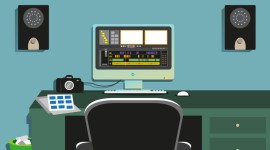
Audio Checklist for Video Editors
Implement these audio tips for success and raise the quality of your video editing projects!

Nothing screams “amateur!” like bad audio. Even if your project has stunning visual images, your project will suffer if proper attention isn’t paid to creating a quality, complimentary audio track. We’ve put together the following tips for the video editor looking to improve the sound mix of their projects!
Only use high-res audio in your projects
MP3s may be useful for web applications, but in video WAVs or AIFFs are better choices. These file types are less compressed and will sound cleaner and crisper. MP3s can also prove to be finicky in some video editing applications, like Final Cut Pro. An additional step you can take to avoid complications in post is ensuring that all the audio elements in your project have the same sample rate – the standard for digital video is 48 kHz. Check out our previous post on the best audio formats for video editing for additional information.
Let music drive the video
Your goal is to use music to enhance the feeling of your video, not work against it. Pull a handful of songs that you think will work for a particular scene or project. Then, VERY roughly lay out the video track and audition each of these songs underneath it to see how they work together. Once you’ve decided on an audio track, then use that music as a guide for editing the video (in most cases cutting to the tempo and beats).
Keep your audio tracks organized
Assign different audio tracks in your project to different audio types. For instance, keep all dialogue on tracks 1-4, all music on tracks 5-8 and all sound effects on tracks 9-10. Think to yourself, “if another editor had to sit down at this project would they be able to quickly identify each audio clip?” It’s best practice to keep the project organized as you go, but it’s ESSENTIAL to clean it up before archiving. Keeping an organized timeline will likely save you time and a bit of sanity.
Use sound effects to enhance action
Sound effects are often one of the last things to get added to a mix, so it likely falls off when you’re up against a deadline. Instead, think of sound effects early in the post process. When you’re reviewing footage take notes of instances where sound effects may add value to a scene. If you’re working with a sound designer, discuss opportunities for incorporating sound effects in the mix. The right sound effects can help set the tone and add pacing to your project. Check out our previous post for other tips on using sound effects to improve your videos.
Don’t skimp on the room tone
Connect with the on-location audio person before the shoot to ensure they’re recording room tone every time the scene or environment changes. Anytime the on-camera sound drops off (this can often happen between cuts) make sure you’re using room tone to cover this audio dead space. This will keep the mix sounding most consistent and be less jarring to the listener.
Test your mix
On what device will your project be seen? With the wide variety of digital video devices it’s important to listen to your mix just as the intended viewer would. Get a strong baseline mix in you audio or video editing application, and then refine it to fit the final delivery format. For instance, you may want to consider adding extra bass to an audio track that will primarily be heard through treble heavy low-grade computer speakers. Keep the final output in mind when doing your final mix.
Utilize meters when setting levels
Your ears will fool you. It’s impossible to keep a consistent mix when adjusting from your own hearing alone. If you’re making adjustments by ear you’ll likely find that the overall mix will get louder and louder through the timeline. As you become accustomed to the audio level you’ll unknowingly raise the audio little by little, so that the end of the project sounds significantly louder than the start. Avoid this editing mistake by utilizing the audio meters within your video editing application. A standard in digital video is to keep most audio around -12 db with audio spikes not exceed 0db (12 db of headroom). If you’re outputting for web it’s likely you’ll want to run the mix a bit hotter to account for computer speakers (around -6db). Everyone’s hearing is different so use the audio meters to get a consistent result.
Have audio tips to share? Let us know in the comments!





